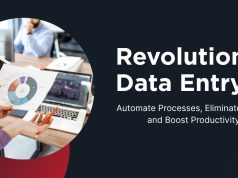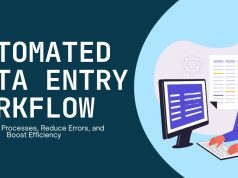Automated data entry in sales saves time, improves accuracy, and lets reps focus on selling. It boosts productivity, speeds up lead response, and provides real-time insights for better sales decisions.
Sales teams spend countless hours typing customer information into CRM systems, updating lead statuses, and manually transferring data between platforms. While this administrative work is necessary for business operations, it pulls valuable time away from what matters most—building relationships with prospects and closing deals.
Automated data entry presents a powerful solution to this challenge. By leveraging technology to handle repetitive data management tasks, sales professionals can redirect their focus toward revenue-generating activities. This shift doesn’t just improve productivity; it can fundamentally transform how sales teams operate and perform.
The benefits extend beyond simple time savings. When data flows seamlessly between systems without manual intervention, accuracy improves dramatically. Sales reps gain instant access to complete customer profiles, interaction histories, and real-time updates that enable more informed conversations with prospects.
What Is Automated Data Entry in Sales?
Automated data entry refers to the use of software tools and technologies that capture, process, and input sales-related information without manual intervention. Instead of sales reps typing customer details, meeting notes, or lead scores into their CRM, these systems handle the data transfer automatically.
This automation can take many forms. Some tools extract information from business cards using optical character recognition (OCR) technology. Others integrate with email platforms to automatically log correspondence and update contact records. Advanced systems can even listen to sales calls and populate CRM fields based on conversation content.
The scope of automated data entry extends across the entire sales pipeline. From initial lead capture through deal closure, automation can handle form submissions, website interactions, social media engagements, and follow-up activities. This comprehensive approach ensures that no valuable prospect information falls through the cracks.
Key Benefits of Sales Data Automation

Increased Productivity and Time Savings
Sales professionals typically spend 20-30% of their time on administrative tasks, with data entry representing a significant portion of this burden. Automated systems can eliminate hours of manual work each week, allowing reps to focus on prospect research, relationship building, and deal advancement. You might also benefit from how to automate browser data entry to speed up repetitive workflows.
Consider a sales rep who previously spent two hours daily updating contact information, logging calls, and transferring leads between systems. Automation can reduce this to minutes, creating an additional 8-10 hours per week for selling activities. Over a year, this time savings translates to meaningful revenue impact.
Enhanced Data Accuracy and Consistency
Manual data entry introduces human error into sales processes. Typos in contact information lead to failed communications. Inconsistent data formats create confusion and duplicate records. Missing information results in incomplete prospect profiles that hinder effective selling. Tools like automated data entry from PDF to Excel help maintain consistency across platforms.
Automated data entry systems apply consistent formatting rules and validation checks that dramatically improve data quality. They capture information exactly as provided, eliminating transcription errors. Integration between systems ensures that updates in one platform automatically sync to others, maintaining data consistency across the sales stack.
Improved Lead Response Times
Speed matters in sales. Research shows that companies responding to leads within five minutes are 100 times more likely to connect with prospects than those waiting 30 minutes. Automated data entry enables faster lead processing by instantly capturing and routing new prospects to appropriate sales reps.
When lead forms auto-populate CRM records and trigger immediate notifications, sales teams can respond while prospects are still actively engaged. This rapid response capability can be the difference between winning and losing deals in competitive markets.
Better Sales Insights and Reporting
Clean, consistent data enables more accurate sales reporting and forecasting. When information flows automatically into CRM systems, managers gain real-time visibility into pipeline activity, conversion rates, and team performance metrics.
Automated data capture also ensures that important interactions don’t go unrecorded. Email exchanges, website visits, and social media engagements all contribute to comprehensive prospect profiles that inform sales strategies and reveal buying patterns.
Essential Tools for Automated Data Entry

Customer Relationship Management (CRM) Integration
Modern CRM platforms serve as the foundation for sales data automation. Leading systems like Salesforce, HubSpot, and Pipedrive offer extensive integration capabilities that connect with email providers, marketing platforms, and communication tools.
These integrations enable automatic contact creation, lead scoring updates, and activity logging. When prospects fill out web forms, attend webinars, or download content, this information flows directly into CRM records without manual intervention.
Email and Communication Automation
Email remains a primary channel for sales communication, making email automation tools essential for data entry efficiency. Platforms like Outreach, SalesLoft, and Mixmax automatically log email interactions, track engagement metrics, and update contact records based on recipient behavior.
These tools also enable automated follow-up sequences that maintain prospect engagement while capturing response data. When prospects reply to automated emails, the systems log these interactions and alert sales reps to continue personalized conversations.
Lead Capture and Form Automation
Website visitors and marketing campaigns generate numerous leads that require immediate processing. Lead capture tools like Typeform, Gravity Forms, and Marketo automatically transfer form submissions into CRM systems, applying lead scoring rules and routing protocols.
Advanced lead capture platforms can pre-populate forms using visitor data, reducing friction while gathering comprehensive prospect information. This seamless experience improves conversion rates while ensuring complete data capture.
Sales Intelligence and Prospecting Tools
Tools like ZoomInfo, Apollo, and Outreach provide automated prospecting capabilities that research and populate prospect data from various sources. These platforms can automatically enrich existing contact records with additional information like job titles, company details, and social media profiles.
Some prospecting tools also monitor prospect activities and trigger automated data updates when contacts change jobs, companies get acquired, or other significant events occur. This real-time intelligence keeps sales databases current without manual research.
Implementing Automated Data Entry Successfully

Assess Your Current Data Entry Processes
Before implementing automation, conduct a thorough audit of existing data entry workflows. Document how information currently flows through your sales process, identifying bottlenecks, redundancies, and error-prone manual steps.
Map out all data sources, including web forms, email communications, social media interactions, and external databases. Understanding these data flows helps prioritize which processes will benefit most from automation and ensures comprehensive coverage.
Choose the Right Automation Tools
Select tools that integrate well with your existing sales stack and can scale with your business growth. Consider factors like ease of use, implementation time, ongoing maintenance requirements, and total cost of ownership.
Start with high-impact, low-complexity automations before moving to more sophisticated implementations. This phased approach allows teams to adapt gradually while demonstrating quick wins that build momentum for broader adoption.
Train Your Sales Team
Successful automation implementation requires proper team training and change management. Sales professionals need to understand how automated systems work, what data they capture, and how to leverage this information effectively.
Provide hands-on training sessions that demonstrate automation benefits through real scenarios. Address concerns about technology replacing human jobs by emphasizing how automation enables more strategic, relationship-focused selling activities.
Monitor and Optimize Performance
Regularly review automation performance to ensure systems are working as intended. Monitor data quality metrics, integration reliability, and user adoption rates. Gather feedback from sales teams about system effectiveness and areas for improvement.
Establish data governance protocols that maintain system integrity over time. This includes regular data cleanup, duplicate management, and validation rule updates as business processes evolve.
Common Challenges and Solutions
Data Integration Complexities
Different systems often use incompatible data formats, making seamless integration challenging. Address this by choosing tools with robust API capabilities and working with experienced implementation partners who understand data mapping requirements.
Consider using middleware platforms like Zapier or Microsoft Power Automate that can bridge gaps between systems and handle complex data transformations without custom development.
Maintaining Data Quality Standards

Automated systems can perpetuate data quality issues if not properly configured. Establish clear data standards and validation rules before implementing automation. Regular data audits help identify and correct quality issues before they impact sales effectiveness.
Create feedback loops that allow sales teams to report data inaccuracies and suggest improvements. This collaborative approach ensures that automated systems continue meeting user needs over time.
Balancing Automation with Personalization
While automation improves efficiency, maintaining personal connections with prospects remains crucial. Design automated workflows that enhance rather than replace human interactions, using technology to provide better context and insights for personalized outreach.
Set clear boundaries around which activities should remain manual versus automated. Complex negotiations, relationship building, and strategic conversations require human expertise that automation cannot replace.
Real-Time Pipeline Management
Automated data entry transforms pipeline management from a reactive process into a proactive one. When new leads are captured and updated automatically, sales managers can monitor deal progression in real-time. This visibility allows for timely interventions—such as reallocating resources to high-priority opportunities or addressing stalled deals—ensuring the pipeline remains healthy. Learn more about real-time data sync tools to enhance sales operations.
Automating Post-Sale Activities
Data entry automation doesn’t end at lead conversion—it extends into post-sale processes as well. Order confirmations, contract management, onboarding tasks, and follow-up surveys can all be logged automatically. This streamlines customer handoffs, reduces administrative overhead, and ensures that every step of the customer journey is recorded. Teams can focus on nurturing client relationships and upselling opportunities, supported by accurate and up-to-date post-sale data.
Future-Proofing Sales Operations
Sales organizations that adopt automated data entry position themselves for long-term growth. As technology evolves, automation tools are increasingly capable of handling more complex tasks, such as AI-driven insights, natural language processing, and integration with emerging platforms like chatbots or virtual assistants. Companies that embrace these capabilities now gain a competitive edge by building scalable, data-driven sales operations that can adapt to changing markets and customer expectations.
See AI and machine learning transforming marketing analytics for insight into advanced capabilities.
Measuring Success and ROI
Key Performance Indicators
Track specific metrics that demonstrate automation value, including time saved on administrative tasks, data accuracy improvements, lead response times, and conversion rate changes. These quantitative measures help justify automation investments and identify optimization opportunities.
Monitor user adoption rates and satisfaction scores to ensure teams are effectively leveraging automated capabilities. Low adoption often indicates training gaps or system usability issues that require attention.
Calculating Return on Investment
Calculate automation ROI by comparing implementation costs against productivity gains and revenue improvements. Factor in both direct savings from reduced manual labor and indirect benefits like improved data quality and faster lead processing.
Consider long-term benefits including scalability improvements and competitive advantages gained through enhanced sales capabilities. These strategic benefits often exceed immediate cost savings.
Transform Your Sales Operations Today
Automated data entry represents more than a simple efficiency improvement—it’s a fundamental shift toward data-driven sales operations that scale with business growth. Organizations that embrace this technology gain significant competitive advantages through improved responsiveness, better data insights, and more strategic resource allocation.
The key to successful implementation lies in thoughtful planning, proper tool selection, and comprehensive team training. Start by identifying your highest-impact automation opportunities and implementing solutions that integrate well with existing processes.
Ready to eliminate manual data entry from your sales process? Begin by auditing your current workflows and identifying repetitive tasks that consume valuable selling time. The investment in automation technology will pay dividends through improved productivity, better data quality, and ultimately, increased revenue growth.
Frequently Asked Questions (FAQ)
Can automated data entry adapt to different sales workflows?
Yes. Modern solutions are highly customizable, allowing teams to configure workflows, field mappings, and validation rules according to specific sales processes. Whether you follow a B2B, B2C, or hybrid model, automation can be tailored to match your workflow requirements.
Will automation affect the personal touch in sales?
No. In fact, automation enhances personalization by freeing sales reps to spend more time on relationship-building activities. By handling repetitive tasks, the system ensures reps can engage prospects with contextually relevant, timely communications.
Can automated systems capture data from phone calls or meetings?
Advanced platforms equipped with AI-powered speech recognition can transcribe calls, detect key phrases, and populate CRM fields automatically. Meeting notes can also be captured and organized without manual input, ensuring a complete record of interactions.
How do I ensure data security with automation?
Reputable automated data entry solutions employ encryption, access control, secure cloud storage, and audit trails. Regular security assessments and compliance with data protection regulations are critical for maintaining confidentiality and mitigating risk.
Does automated data entry work for small sales teams?
Absolutely. Even small teams benefit from time savings, data accuracy, and better insights. Automation allows lean teams to handle a higher volume of leads efficiently, improve pipeline management, and scale without immediately increasing headcount.
How do I measure the impact of automated data entry on sales performance?
Track metrics like time spent on administrative tasks, lead response times, data accuracy, CRM adoption rates, and overall sales conversion. Comparing pre- and post-automation performance provides insight into efficiency gains and ROI.










